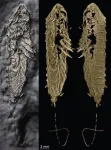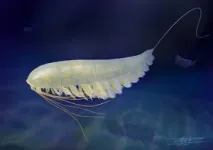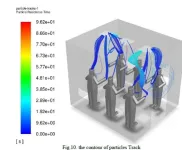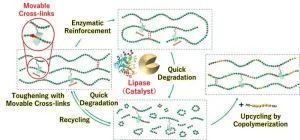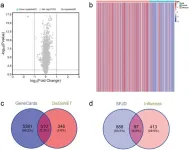(Press-News.org) UNDER EMBARGO UNTIL 15:00 GMT / 11:00 ET TUESDAY 29 OCTOBER 2024
Gold bugs: spectacular new fossil arthropod preserved in fool’s gold
Images available via link in the notes section
A new 450-million-year-old fossil arthropod, preserved in 3D by iron pyrite (fool’s gold), has been unveiled by scientists.
The new species, Lomankus edgecombei, is distantly related to spiders, scorpions, and horseshoe crabs.
The findings have been published today (29 Oct) in the journal Current Biology.
A team of researchers led by Associate Professor Luke Parry, Department of Earth Sciences, University of Oxford, have unveiled a spectacular new 450-million-year-old fossil arthropod (the group that contains spiders, centipedes, and insects). Besides being an extraordinary-looking new scientific species, the specimens are entirely preserved by fool’s gold.
Associate Professor Parry said: “As well as having their beautiful and striking golden colour, these fossils are spectacularly preserved. They look as if they could just get up and scuttle away.”
The new fossil, named Lomankus edgecombei, after arthropod expert Greg Edgecombe of London’s Natural History Museum, belongs to a group called megacheirans, an iconic group of arthropods with a large, modified leg (called a “great appendage”) at the front of their bodies that was used to capture prey.
Megacheirans like Lomankus were very diverse during the Cambrian Period (538-485 million years ago) but were thought to be largely extinct by the Ordovician Period (485-443 million years ago).
This discovery offers important new clues towards solving the long-standing riddle of how arthropods evolved the appendages on their heads: one or more pairs of legs at the front of their bodies modified for specialised functions like sensing the environment and capturing prey. Such appendages include the antennae of insects and crustaceans, and the pincers and fangs of spiders and scorpions.
“Today, there are more species of arthropod than any other group of animals on Earth. Part of the key to this success is their highly adaptable head and its appendages, that has adapted to various challenges like a biological Swiss army knife” Associate Professor Parry continued.
While other megacheirans used their large first appendage for capturing prey, in Lomankus the typical claws are much reduced, with three long and flexible whip-like flagella at their end. This suggests that Lomankus was using this frontal appendage to sense the environment, rather than to capture prey, indicating it lived a very different lifestyle to its more ancient relatives in the Cambrian Period. Unlike other megacheirans, Lomankus seems to lack eyes, suggesting that it relied on its frontal appendage to sense and search for food in the dark, low-oxygen environment in which it lived.
“Rather than representing a ‘dead end’, Lomankus shows us that megacheirans continued to diversify and evolve long after the Cambrian, with the formerly fearsome great appendage now performing a totally different function” Associate Professor Parry continued.
The fossil offers new clues towards solving the highly-debated question of what the equivalent of the great appendage of megacheirans is in living species. Co-corresponding author Professor Yu Liu (Yunnan University) said: “These beautiful new fossils show a very clear plate on the underside of the head, associated with the mouth and flanked by the great appendages. This is a very similar arrangement to the head of megacheirans from the early Cambrian of China except for the lack of eyes, suggesting that Lomankus probably lived in a deeper and darker niche than its Cambrian relatives.”
This arrangement of features on the head is similar to living arthropods, suggesting the great appendage is the equivalent of the antenna of insects and the chelicera (mouthparts) of spiders and scorpions.
The fossil was found at a site in New York State, USA that contains the famous ‘Beecher’s Trilobite Bed’; a layer of rock containing multiple trilobites with incredible preservation. Aside from trilobites, other kinds of organisms are much less common at this site, reflecting the rarity of this find.
The animals preserved in Beecher’s Trilobite Bed lived in a hostile, low oxygen environment that allowed pyrite, commonly known as fool’s gold, to replace parts of their bodies after they were buried in sediment, resulting in spectacular golden 3D fossils. Pyrite is a very dense mineral, and so fossils from this layer can be CT scanned to reveal hidden details of their anatomy. This technique involves rotating the specimen while taking thousands of X-ray images, allowing the fossils to be reconstructed in three dimensions.
Professor Derek Briggs, a co-author of the study at Yale University said: “These remarkable fossils show how rapid replacement of delicate anatomical features in pyrite before they decay, which is a signature feature of Beecher’s Trilobite Bed, preserves critical evidence of the evolution of life in the oceans 450 million years ago.”
Notes:
For media enquiries and interview requests, contact Associate Professor Luke Parry luke.parry@earth.ox.ac.uk
Images relating to the study which can be used in articles can be found at https://drive.google.com/drive/folders/1NHMFLgwxxKuyt6xWfw2xhk_cVOBHuAxm?usp=drive_link These images are for editorial purposes relating to this press release only and MUST be credited (see captions document in file). They MUST NOT be sold on to third parties.
The study ‘A pyritised Ordovician leanchoiliid arthropod’ will be published in Current Biology at 15:00 GMT / 11:00 ET Tuesday 29 October 2024 at https://doi.org/10.1016/j.cub.2024.10.013
To view a copy of the study before this under embargo, contact Luke Parry: luke.parry@earth.ox.ac.uk
About the University of Oxford
Oxford University has been placed number 1 in the Times Higher Education World University Rankings for the ninth year running, and number 3 in the QS World Rankings 2024. At the heart of this success are the twin-pillars of our ground-breaking research and innovation and our distinctive educational offer.
Oxford is world-famous for research and teaching excellence and home to some of the most talented people from across the globe. Our work helps the lives of millions, solving real-world problems through a huge network of partnerships and collaborations. The breadth and interdisciplinary nature of our research alongside our personalised approach to teaching sparks imaginative and inventive insights and solutions.
Through its research commercialisation arm, Oxford University Innovation, Oxford is the highest university patent filer in the UK and is ranked first in the UK for university spinouts, having created more than 300 new companies since 1988. Over a third of these companies have been created in the past five years. The university is a catalyst for prosperity in Oxfordshire and the United Kingdom, contributing £15.7 billion to the UK economy in 2018/19, and supports more than 28,000 full time jobs.
END
Gold bugs: Spectacular new fossil arthropod preserved in fool’s gold
2024-10-29
ELSE PRESS RELEASES FROM THIS DATE:
Optimal standing positions and ventilation in airport smoking lounges
2024-10-29
WASHINGTON, Oct. 29, 2024 – While many smoking rooms in U.S. airports have closed in recent years, they are still common in other airports around the world. These lounges can be ventilated, but how much does it actually help the dispersion of smoke?
Research published in Physics of Fluids, by AIP Publishing, shows that not all standing positions in airport smoking lounges are created equal.
Researchers from the University of Hormozgan in Iran studied nicotine particles in a simulated airport smoking room and found that the thermal environment and positioning of smokers influenced how particles ...
Ancient gene influences immunity of First Nations Peoples of Oceania
2024-10-29
AURORA, Colo. (Oct. 29, 2024) – An ancient gene mutation among First Nations inhabitants of Oceania may make them more susceptible to infectious diseases like influenza, according to a new study by scientists at the University of Colorado Anschutz Medical Campus.
“We found quite a diverse set of genes in this population but there was one allele that really stood out in terms of genetic composition,” said the study’s lead author Paul Norman, PhD, professor of biomedical informatics at the University of Colorado School of Medicine. “We did some investigating, and we suspect this allele ...
The Megacheiran candidate: Fossil hunters strike gold with new species
2024-10-29
New Haven, Conn. — Paleontologists have identified fossils of an ancient species of bug that spent the past 450 million years covered in fool’s gold in central New York.
The new species, Lomankus edgecombei, is a distant relative of modern-day horseshoe crabs, scorpions, and spiders. It had no eyes, and its small front appendages were best suited for rooting around in dark ocean sediment, back when what is now New York state was covered by water.
Lomankus also happens to be bright gold — thanks to layers of pyrite ...
Advanced biodegradable plastics run rings around their predecessors
2024-10-29
Osaka, Japan—Achieving a sustainable society requires the development of advanced degradable plastics, or polymers, which are molecules composed of long chains of repeating units. The goal of a resource-circulating society is now one step closer thanks to the efforts of a team from Osaka University that has developed tough biodegradable plastics by including movable crosslinking groups.
In a study published this month in Chem, the researchers have revealed that developing polymers with movable crosslinks not only increases their strength but also promotes degradation by enzymes under mild conditions.
Plastics and polymers need to achieve both desirable performance ...
Suicide-related emergencies underdetected among minority, male youth, and preteens, study finds
2024-10-29
A new study by UCLA Health reveals that hospital emergency departments may be missing signs of suicidal thoughts and behaviors in children, boys and Black and Hispanic youth.
The research, published in the journal JAMA Open Network, analyzed electronic health records of nearly 3,000 children and teenagers presenting to two emergency departments in southern California for mental health reasons. Using machine learning algorithms, the researchers determined standard medical record surveillance methods miss youth with suicide-related emergencies. These methods disproportionately missed suicide-related visits among Black, Hispanic, male, and preteen youths, compared with ...
The molecular mechanism of Shufeng Jiedu capsules in the treatment of influenza: A comprehensive analysis based on network pharmacology, bioinformatics, and molecular docking
2024-10-29
Background and objectives
Shufeng Jiedu Capsules (SFJD), a traditional Chinese medicine preparation, are widely used in the clinical treatment of influenza, yet their mechanism of action remains unclear. This study aimed to systematically explore the molecular mechanism of SFJD in the treatment of influenza using network pharmacology and bioinformatics techniques.
Methods
The active ingredients of SFJD were retrieved from traditional Chinese medicine databases, and their targets were identified using the Swiss Target Prediction and TCMSP databases. Influenza disease genes were obtained from the GEO, GeneCards, and DisGeNET ...
Treating severe calcification with an atherectomy device does not improve cardiac stenting outcomes, study finds
2024-10-29
Routine use of an orbital atherectomy device to remove calcium from severely blocked coronary arteries before patients undergo cardiac stenting procedures does not improve outcomes, a Mount Sinai-led study has found.
The results of the ECLIPSE study were announced during a late-breaking trial presentation at the Transcatheter Cardiovascular Therapeutics Annual Meeting on Tuesday, October 29. This is the first large-scale study to study this specific device in severely calcified lesions, and the results support reserving its use for extreme cases.
“Operators across the United States currently have different thresholds ...
Access to patient questionnaire improves spine MRI diagnosis
2024-10-29
OAK BROOK, Ill. – Knowing a patient’s symptoms helps radiologists in lumbar spine MRI interpretation and diagnosis, according to a study published today in Radiology, a journal of the Radiological Society of North America (RSNA).
MRI is the most important imaging exam in patients with back pain or sciatica because it shows nearly all degenerative and structural abnormalities of the spine.
However, MRI often shows spinal abnormalities in individuals who do not have symptoms. Because the same abnormalities can ...
Using AI to measure prostate cancer lesions could aid diagnosis and treatment
2024-10-29
Prostate cancer is the second most common cancer in men, and almost 300,000 individuals are diagnosed with it each year in the U.S. To develop a consistent method of estimating prostate cancer size, which can help clinicians more accurately make informed treatment decisions, Mass General Brigham researchers trained and validated an AI model based on MRI scans from more than 700 prostate cancer patients. The model was able to identify and demarcate the edges of 85% of the most radiologically aggressive prostate lesions. Tumors with a larger volume, as estimated by the AI model, ...
Study uncovers alarming patterns in the effects of family violence
2024-10-29
A new synthesis of global evidence highlights a strong connection between family violence and long-term health consequences, significantly impacting the psychological and physical well-being of millions worldwide. This comprehensive review, the first of its kind, synthesises the findings from the most rigorous studies on child maltreatment and intimate partner violence, uncovering alarming patterns in the long-term effects of family violence.
According to the study, led by Matthias Burghart of the Max Planck Institute for the Study of Crime, Security, and Law, and Sophia ...
